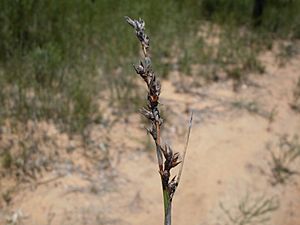Pale twig-rush facts for kids
Quick facts for kids Pale twig-rush |
|
|---|---|
 |
|
| Scientific classification | |
| Genus: |
Baumea
|
| Species: |
acuta
|
The Baumea acuta, also known as pale twig-rush, is a type of flowering plant. It belongs to the sedge family, which is called Cyperaceae. This plant grows naturally in the southern parts of Australia.
About the Pale Twig-Rush
The pale twig-rush looks a lot like grass. It is a perennial plant, meaning it lives for more than two years. It also has special underground stems called rhizomes that help it spread.
This plant usually grows about 0.2 to 0.4 meters (around 1 foot) tall. It can spread out to about 1 meter (3 feet) wide. Its flowers are brown and usually appear between September and November.
Plant Names and History
Plants often have scientific names that can sometimes change. The pale twig-rush was first officially described in 1805. A scientist named Jacques Labillardière gave it the name Schoenus acutus back then.
Later, in 1902, another scientist named Eduard Palla changed its name. He reclassified it as Baumea acuta. This is the scientific name it uses today.
Where It Grows
You can find the pale twig-rush in many places across southern Australia. It grows along the southern coasts of both the east and west sides of the mainland. It is also found in coastal areas of Tasmania.
On the east coast, it grows in coastal parts of southern Queensland, New South Wales, and Victoria. It also extends to the far east coast of South Australia.
In Western Australia, it often grows in thick groups. You can find it in wet areas during winter, like around swamps. It prefers damp, sandy soils in coastal regions. These areas include Peel, South West, Great Southern, and Goldfields-Esperance.

